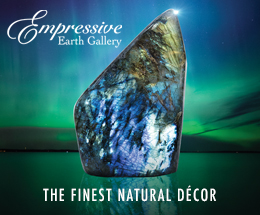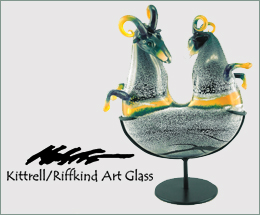
While most people think of diamonds and other similar stones as gems, there are other more unusual minerals that also fall under the classification. For me, finding those minerals is a passion that takes me all over the world.
The minerals, corals and fossils at my company, Empressive Earth Gallery, come from many different countries across six continents. I travel the globe in search of remarkable and unusual specimens and make direct connections with miners, diggers, divers and other individuals who uncover these pieces.
As a geologist/paleontologist and gemologist, I utilize my training to acquire high-quality minerals, corals and fossils for exquisite décor. I received my bachelor’s degree in geology and master’s degree in mining and geological engineering, as well as a Graduate Gemologist diploma from the Gemological
Institute of America (GIA). I am also a Registered Master Valuer and an Accredited Member of the International Society of Appraisers, specializing in the valuation of minerals, corals and fossils.
Almost all the minerals that I acquire are also classified as gemstones. While this technically makes them ideal for faceting and, ultimately, use in jewelry, my focus is to preserve the natural state of the crystals. The vast majority of our minerals remain uncut, although they are compositionally still the same material that is also admired in fine jewelry.
Gemstones can be examined for the four C’s, which are color, cut, carat and clarity. The combination of these characteristics has a significant impact on the value of a stone. In the standard gem and jewelry industry, the four C’s are mainly utilized to grade diamonds, although its concepts can also be applied to a myriad of other types of gemstones. It is also important to be aware that artificial enhancements and dubious methods are often used to improve these attributes, and this often requires a certain level of expertise to identify and avoid.
When it comes to color, there are a few colorless varieties of stones that are like diamonds in that less of a tint is considered ideal due to greater purity. However, since most gem varieties are actually “colored stones,” the opposite is true in most cases. Vivid and saturated colors are generally more valued than faded hues.
Cut is based on the shape and facets of a gemstone, which has an impact on its visual appeal as well as how it transmits light and sparkles. In the case of natural formations, fully defined crystals with prominent structures would typically be considered superior to those that are only partially formed or distorted. Brightness, fire and scintillation are also carefully considered.
Carat refers to the weight of gemstones, although most of our mineral specimens would be weighed by kilograms or pounds due to their size. It is also necessary to understand that this characteristic often has more relevance when examining the overall size of a piece rather than weight. The size of the individual crystals must also be considered, since larger crystals are more rare than smaller crystals of the same mineral type.
Clarity refers to the relative absence of inclusions and flaws and how clear the stone appears. The most straightforward aspect of this is whether the stone is transparent, cloudy or opaque to varying degrees due to fluid inclusions or other imperfections. A clear and pristine crystal would be of ideal clarity. However, it is important to keep in mind that some stones are inherently opaque and, thus, clarity may not be a factor.
I’d also like to mention that the four C’s can alternatively be interpreted as the five C’s. The condition of the stone is traditionally considered as part of the clarity category for diamonds, although I record it separately in other stones. Condition examines how the fractures, nicks, scratches and other damage or imperfections detract from the clarity and/or aesthetics.
Although minerals are considered fine art, like paintings or sculptures, the aforementioned attributes for gemstones still serve as the foundation for understanding their value. Keeping these concepts in mind will be advantageous when you are next looking to acquire a special piece for your home or office. *
Micah Gilbert is a geologist/paleontologist and gemologist with a trained eye for meticulously sourcing high-quality specimens that make for exquisite décor. He is the owner of Empressive Earth Gallery.
Empressive Earth Gallery
1339 E. Levee St.
Dallas, TX 75207
214.343.0000
empressive.com












